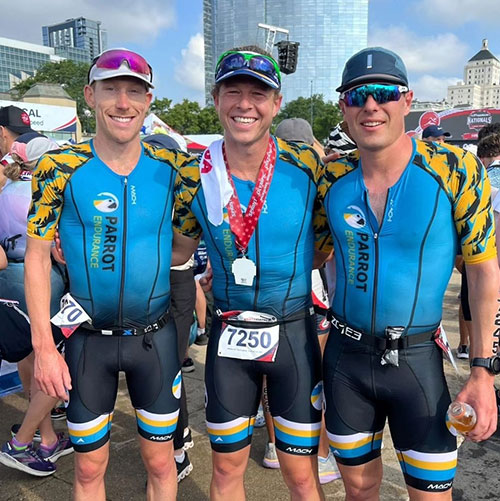Let’s not sugar coat it, training really sucks sometimes. Even on easy days, you may feel like you are swimming through Jell-O or running on quicksand. So, when should you start to be concerned about the frequency of feeling like crap? That’s where the rule of thirds comes into play.
The rule of thirds is that 1⁄3 of our training will feel amazing; 1⁄3 of our training will be just “meh,” and nothing special; and 1⁄3 of our training will be utterly miserable. I know that isn’t very fun to think about, but it is generally how our workouts break down when training 10+ hours each week. So, let’s talk about how to deal with the 1⁄3 of workouts that feel terrible and how to embrace the fantastic workouts when we need it most.
Bad news first, you will inevitably have 1⁄3 of your workouts feel miserable. There will be plenty of days when you will be sore, work stress is getting the best of you, you didn’t eat enough, or something else out of your control is putting you in a bad mood. When this happens, athletes should adopt a strategy called “chunking.” No, it has nothing to do with throwing up or pooping; instead, it is a strategy to approach your most difficult workouts. Chunking means breaking up a workout into bite-sized manageable “chunks” that allow you to focus on the interval in front of you. In a swim workout for example, if you have a set of 12 x 100’s, maybe you break this up in your mind into three sets of four, and you don’t allow yourself to think about anything besides the set you are currently swimming. After you finish each 100 you have finished 25% of the first chunk. Similarly, if you’re on a 3-hour bike ride, maybe you break it into 6, 30-minute segments and time your nutrition around interval changes to make the time go by much quicker.
I won’t sugar coat it; this is nothing more than playing tricks on yourself, but it really works well! Some sport psychology studies1 have shown increased performance by athletes that are given the verbal cue to “chunk” the workout as compared to athletes who are given no verbal or mental cue. So, when you’re having a bad day, a really tough workout, or are just intimidated by a set, take it in chunks and speak it into existence. I’m willing to bet that allowing yourself to accomplish these bite-sized chunks will not only build confidence, but more importantly, keep you present during the workout. Staying present reduces the likelihood of quitting and will allow you to focus on the goal right in front of you!
Second, the mediocre and feel good 2/3’s of our workouts are generally easier to get through. These workouts may be easy or at threshold, and you may be crushing them! Regardless of the workout’s intensity, it’s incredibly important to take a minute or two after these workouts and reflect on the accomplishment. The workout may have been an easy 35-minute run that barely got your heart rate to zone 2; but have some serious gratitude for your body. Actively practicing gratitude after these feel-good workouts make long-horizon training so much more palatable.
So how do we know which workouts are going to feel bad, middle of the road, or great? It depends. Some days you will roll out of bed and feel like a world champion, but then your workout feels like do- do. Other days it will take every ounce of your willpower just to start the workout; you’ll bargain and procrastinate with yourself, but you’ll eventually get going, and after the first 10 minutes you may start to feel so much better. We can sometimes predict the outcome based on sleep quality, hydration, nutrition, work stress, or life stress, but other times we just won’t know until we get started. That’s why taking the first step and giving it a try is so important. The bottom-line is: don’t let your soreness or fear of a tough workout prevent you from starting in the first place and having a good attitude. You never know what may happen after you start. It is true that it may be just as bad as you imagined, but more often than not, it will go better, and I promise that you’ll be thankful for giving yourself the opportunity to succeed.
So, embrace the bad workouts with a bite-sized approach that keeps you present in the moment, know that the bad days are limited even though they seem to drag on forever, and always believe in yourself, because every day is an opportunity!
1 https://www.nsca.com/contentassets/149a04fefb5340d4914290480580b1d6/coaching-instructions-and-cues-for-enhancing-sprint-performance.pdf?srsltid=AfmBOoqzSDcSaI57Flwa5v4upbXPooVSQnVWE4dTg0QcTNC2etz2oGJk

Matt Nadel
Unleash Your Athlete
Matt loves the process and lifestyle of being an endurance athlete. He has been coaching swimmers for over 15 years, triathletes for 7 years, and is an Ironman U certified coach. Matt was a swimmer at Colorado College where he was an NCAA All-American and held multiple team records in the distance freestyle events. He quickly jumped into triathlon after college and fell in love with the endurance community while racking up multiple AG wins in local races. As an environmental lawyer by day, Matt understands the constraints of working professionals and he personalizes training for his athletes to find how triathlon fits into their lives and how they can make endurance sports a lifelong, joy-filled process.
Contact Matt to start your endurance journey with Unleash Your Athlete: matthewcnadel@gmail.com or 303-908-0510.






